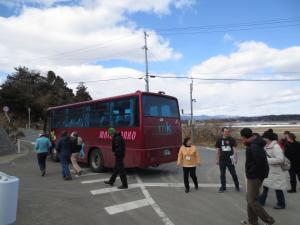This was my second JET Study Tour, the first being to Iwaki. That town had escaped much of the tsunami damage and radiation, though the town had been hard-hit. Soma and Minami-Soma, on the other hand, faced some of the highest recorded heights of the tsunami, and parts of Minami-Soma remain evacuated three years later. I had been to Minami-Soma once before, and I am good friends with an ALT there, but I still wanted to learn more about the area, and the recovery efforts taking place there. Before arriving in Soma, we visited a Radiation Information Center in Fukushima city and listened to an overview of the radiation situation in the prefecture. Essentially, the radiation from the plant drifted Northwest after the accident, and then hooked south. We got to see how they are decontaminating places around Fukushima, and learned how radiation could affect the body. In Soma, we spoke to a man at a fishing co-op on trial fishing in the Soma area. Fishing is still not allowed in the waters around Fukushima due to radiation, but fisherman are starting to catch some fish and check their radiation levels, as well as seeing if there’s any demand for the fish. We then went strawberry picking! They gave us a tray with cream and then let us eat as many strawberries as we wanted inside the greenhouse. They were all delicious, and we left stuffed! After picking, we travelled to the main shrine in Soma, where they bless the horses for the Soma Noma Oi- an annual Samurai-style horse race. The next day, we took an hour-long bus ride to Minami-soma, a collection of villages that were more directly affected by the radiation disaster. The most haunting part of the tour was spent touring Odaka village, which remains evacuated. People are now allowed to visit during the day, but they can’t stay the night. The area is the most damaged area I have ever seen. In other parts of Fukushima, people have rebuilt the businesses and repaved the roads, but because of the evacuation Odaka still looks much like it did three years ago. There is really nothing there except for overgrown rice fields, piles of debris, and abandoned houses. Many people will never be able to return to their homes, because the government has decided their houses are in flood-prone areas. It was sad to see so much emptiness in an area that was once just another pleasant small town. We also visited Buddha carvings that dated from the Heian period, and were spared by the tsunami. It was hard to see how Odaka will be able to recover from the nuclear disaster. We ended the tour on an optimistic note by visiting the Solar Agri-Park. Run by a former TEPCO director, the solar panels produce some electricity for the area, but are primarily used as an area for children to learn about solar power and spark interest in alternative energy. The owner pointed out that if Fukushima wants to avoid using nuclear power plants, they must start exploring solar and wind energy. His enthusiasm was infectious, and we all left excited for what he planned to do. Overall, the tour was incredibly enlightening and sparked my interest in the area. I appreciated receiving more information about the disaster, so I can tell my family some concrete facts about the situation in Fukushima. |  |
| Summary |







